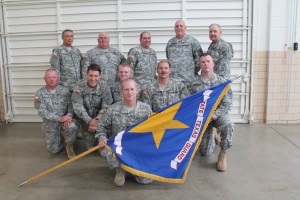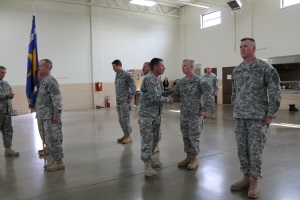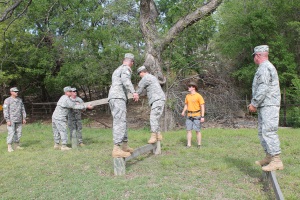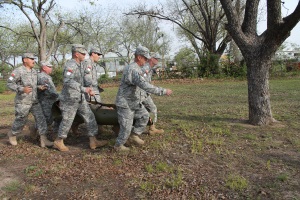Story by: CW2 Janet Schmelzer, 4th Regiment PAO
Posted: 1-JUN-14
Team Wins First Place in Two of Five Challenges.
STEPHENVILLE, Texas--The 4th Regiment Gonzales Cup Team competed with 15 fellow soldiers from the 8th Regiment and the 19th Regiment at the Texas State Guard (TXSG) second annual team and individual competition held at different venues in Stephenville and Erath County, Texas, from April 11-12, 2014. The National Guard Armory in Stephenville served as the base for the competition and as billeting for the soldiers.
The 4th Regiment team won two of the five team challenges--the ropes challenge course and the life-saving exercise. Overall, the team had an outstanding performance and made the 4th Regiment proud.
 4th Regiment Gonzales Cup Team with 4th Regiment Support Personnel (first row left to right) SSG Gary Harvel, CPL Justin Carter, SPC Stephen Walton, SSG Dennis Burks (in front), CPL Joe Ringnald, PFC David Anderson; (second row left to right) CSM Albert Willars, SFC Richard Shillling, WO Ray Spoth, COL Howard Palmer, Jr., and LTC Lloyd Lietz.
4th Regiment Gonzales Cup Team with 4th Regiment Support Personnel (first row left to right) SSG Gary Harvel, CPL Justin Carter, SPC Stephen Walton, SSG Dennis Burks (in front), CPL Joe Ringnald, PFC David Anderson; (second row left to right) CSM Albert Willars, SFC Richard Shillling, WO Ray Spoth, COL Howard Palmer, Jr., and LTC Lloyd Lietz.
The 4th Regiment team included team leader SSG Gary Harvel, CPL Joe Ringnald, and PFC David Anderson of the 1st Battalion, CPL Justin Carter and SPC Stephen Walton of the 2nd Battalion, and SSG Dennis Burks of the 3rd Battalion. Each member put forth 100% effort, demonstrated skill and endurance, and excelled at teamwork which resulted in a top-notch performance.
The Gonzales Cup team competition tested five skill sets. The first competition was physical fitness. At the Tarleton State University Track and Field Course, in Stephenville, Texas, the physical fitness test challenged each soldier to complete as many sit-ups and push-ups as possible in 2 minutes followed by a mile run. Ringnald considered the physical fitness challenge very important. “Physical fitness never stops. It is the way we should live every day." Of all the competitors Ringnald came in 3rd and Anderson came in 6th.
The second competition was the 9mm pistol marksmanship held at the Tac Pro Shooting Range in Erath County. Ringnald earned the top score for the team and Anderson was second for the team. Of all of the competitors, Ringnald was 3rd and Anderson was 6th. Team members shot targets 75-feet away in the standing, kneeling, crouching and prone positions to achieve the highest total team score. Anderson saw the marksmanship competition as a "test of concentration and skill which are important to our ability to take on our mission." Burks said the key to better scores is "practice, practice, practice." Carter believed that the competition was a learning experience. "It is good to train and learn from teammates."
The third competition was Land Navigation at the Tarleton State University Hunewell Ranch, in Erath County. Each regiment was divided into two-man teams. The teams of the 4th Regiment were Harvel and Carter; Burks and Ringnald, and Walton and Anderson. The course had thirty-nine markers hidden in the wild brush and mesquite trees as possible using maps, protractors, and compasses within a 2 ½ hour time limit. Each marker was worth from 5 to 15 points. Each 4th Regiment team used strategy and superior execution of land navigation skills.
The fourth competition was at the Tarleton State University Challenge Course which consisted of three challenges: "Human Sensor Web," "Acid Crossing," and "Perimeter Breach." The 4th Regiment won this competition. The three challenges required teamwork, team strategy, and superior leadership reaction to succeed and to complete each challenge successfully without penalties and in the fastest time possible. The first challenge for the 4th Regiment team was the "Human Sensor Web," which looked like a spider web made of rope. The team had to pass each team member through the web with as little movement as possible so as not to ring the bell suspended in the web.
 At the Awards Ceremony, Army Component Commander BG Jake Betty congratulates the 4th Regiment Team. BG Betty is shaking the hand of SPC Stephen Walton. (left to right) SSG Dennis Burks, CPL Justin Carter, CPL Joe Ringnald, BG Betty, SPC Walton, and PFC David Anderson.
At the Awards Ceremony, Army Component Commander BG Jake Betty congratulates the 4th Regiment Team. BG Betty is shaking the hand of SPC Stephen Walton. (left to right) SSG Dennis Burks, CPL Justin Carter, CPL Joe Ringnald, BG Betty, SPC Walton, and PFC David Anderson.
Once a part of the web had been used, that part of the web could not be used again. The 4th Regiment team successfully passed each member through as well as their equipment. The team passed SPC Walton through the web head first as if he were on a stretcher. The team made the bell ring only once while the other regiments made the bell ring several times. David Meyers, the Outdoor Pursuit Coordinator in Recreational Sports at Tarleton State University, saw the team succeed as a unit. "It is just that basic buddy system which helps the team to work together."
The 4th Regiment team then proceeded to the second ropes course challenge, the “Acid Crossing.” This challenge required the team to build a bridge, using only three 2”x8”x8’ boards to connect together five 12-inch poles buried in the ground. Again, the 4th Regiment team excelled at the challenge. Harvel quickly figured out the solution to the challenge and was the first team member to begin the bridge building, followed by Anderson, Carter, Burks, Walton and Ringnald. As the bridge was built, each team member had to cross from pole to pole on the 2” side of the boards as if walking on a tightrope.
 The 4th Regiment team builds the bridge for the "Acid Crossing" challenge. (left to right)CPL Joe Ringnald, SSG Dennis Burks, SPC Stephen Walton, PFC David Anderson, CPL Justin Carter, and SSG Gary Harvel.
The 4th Regiment team builds the bridge for the "Acid Crossing" challenge. (left to right)CPL Joe Ringnald, SSG Dennis Burks, SPC Stephen Walton, PFC David Anderson, CPL Justin Carter, and SSG Gary Harvel.
The team did not have a single member fall off the bridge whereas other regiments were penalized for members falling off. Walton deemed the team's success to "fluidly working together, trusting each other, and having SSG Harvel as our team leader. This is a great team building experience."
The third ropes course challenge was the 15-foot high “Perimeter Breach” wall which required the 4th Regiment team to lift up the first member, Anderson, who then reached up to grab the top of wall and pull himself to the top of the wall. The second member to be hoisted up was Harvel and Anderson had to pull him up without any assistance. Then Anderson and Harvel pulled up Carter as he was lifted up from below by the remaining three team members. The next two were Burks and Walton. However, once a team member reached the top, he could not return to the front of the wall to help hoist remaining team members. This test continued until only Ringnald was left at the bottom of the wall. Burks and Walton used a rope, which could only be used once in this test, to pull Ringnald to the top without any team members left at the wall to hoist him up. Harvel believed that the competition was “all about team building. The team did it.” Burks stated that he "loved the competition. I wanted to compete on even more obstacles!"
Observing the competition, BG Jake Betty, TXSG Army Component Commander, was pleased with the performance of the soldiers. “The events went very well. I was impressed with the level of enthusiasm of the individuals and teams in their dedication and performance. This event helped build unit esprit de corps, allowing individual soldiers skills and confidence to be tested to be state guard ready.”
On Saturday, April 12, at the National Guard Armory in Stephenville, the final competition was Life Saving Skills. The 4th Regiment team won this competition.The Gulf Coast Medical Response Group, who designed the life saving competition, traveled to Stephenville to conduct the tests which would determine the proficiency of each soldier in three life saving skills. Of all competitors Ringnald tied for 1st, and Harvel, Carter and Burkes tied for 3rd. Each 4th Regiment team member took a test, administered first aid to an unresponsive and unconscious mock victim using CPR and an Automated External Defibrillator, treated a broken arm using splints and bandages, and treated a mock victim for shock and a bleeding arm wound by applying a pressure bandage. The final life-saving test was a wounded casualty extraction which required the team to carry a 200-pound dummy in a skid stretcher over a ½ mile course with trees and a shallow gulley as obstacles in the fastest time possible. Walton viewed the challenge as “learning to trust your teammates to finish a task successfully. All of the life-saving tests were important because these injuries occur in the real world.” Anderson too called the tests "a great, real world hands-on experience as each station presented different life-saving methods." MAJ James Vretis, TXSG Army Component Staff Surgeon, commented that this challenge was “a clear way to evaluate the training for life saving intervention.”
 The 4th Regiment team carries a 200-pound dummy during the wounded casualty extraction challenge.
The 4th Regiment team carries a 200-pound dummy during the wounded casualty extraction challenge.
Although the 19th Regiment had the highest total score and won the Gonzales Cup, the 4th Regiment turned in a performance other regiments should envy and most certainly the 4th Regiment team represented the 4th Regiment to the highest TXSG standards. COL Howard Palmer, Jr., 4th Regiment Commander, stated that he was “very proud of the 4th Regiment team. They demonstrated great esprit d’corps and teamwork.” “The spirit, resilience, and competitiveness of each soldier” he continued, “speaks to the energy and determination of the team to put forth their very best effort to win.” CSM Albert Willars agreed. "This competition demonstrates outstanding training and is a morale builder. It shows exceptional unity and esprit d'corps." Ringnald commented that "it was a great time. I am proud to have worked with my fellow soldiers." Harvel summed up the team's performance. "I am proud of the team. They did a great job. They stepped up to work as a team." Burks looked forward to next year. "We will take it!"
The success of the 4th Regiment team depended on many individuals in the regiment, including each member of the 4th Regiment team, 4th Regiment Commander COL Howard Palmer, Jr., 4th Regiment Executive Officer and Operations and Training Officer LTC Lloyd Lietz, Battalion commanders MAJ Ted Prescott (1st), MAJ Tommy Thompson (2nd), and MAJ Michael Potts (3rd), Assistant Operations and Training Officer WO Ray Spoth, 4th Regiment Senior Enlisted Advisor CSM Albert Willars, Battalion Senior Enlisted Advisors CSM Hayward Bellah (1st), CSM Phillip Holland (2nd), and MSG Freddrik Taylor (3rd), 4th Regiment Operations and Training NCO SFC Richard Schilling, and every member of the regiment who supported the 4th Regiment Team.
The Gonzales Cup represents the courage, strength, and skill that the defenders of Gonzales, Texas, demonstrated while resisting the attack of the Mexican Army during the Texas Revolution in 1835. The Gonzales Cup is engraved with the words "Come and Take It" found on the flag made by the people of Gonzales during the fight.